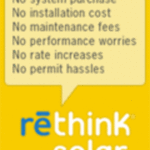How much does sunlight cost in your country or area? Let me guess, it’s free! The benefits of solar energy and its vast abundance are major factors that convince people to convert from conventional fossil fuel energy to solar energy. Some of the basic yet profound applications of solar energy are listed below and can help reduce your electricity bill by a considerable amount.
1) Small, Portable Photovoltaic Systems
Photovoltaic (PV) panels are responsible for converting energy from the sun into electricity, and can be made portable for small applications. You have probably already seen this being used on devices like your calculator! This principle has also been applied to garden appliances, lights, and even solar powered generators that can be used to power home appliances during an emergency. They have the ability to power small items such as radios, toasters and so on. Nowadays you can even buy a portable solar powered charger for your small devices and cell phones that have a USB cable.
2) Home Electricity
The PV panels mentioned above can be expanded and put onto the roofs of homes to provide power for all home applications. Depending on how many solar panels you install, you could end up covering your full energy usage and even have some left over to sell back to the grid! In the US, the government is bringing in more and more incentives to encourage this use of solar energy, and a number of businesses are also taking up the technology.
3) Solar Powered Air Conditioning
Solar power is now being used to help lower electricity bills during hot summer months. This is one of the most practical uses of solar energy thanks to the fact that this is the time of year when the sun will be at its strongest anyway. Another method is to use solar powered attic fans that use power from the sun to run a fan during the day. This fan helps to keep the attic cooler and reduces the temperature of the home as a result.
4) Solar Powered Water Heating Systems
This is another top residential use for solar energy. Heating water accounts for around 20% of the average household energy bill, so using thermal energy from the sun is a great way of cutting down on bills. This can be used even in areas with less sunlight, if supplemented with traditional heating for times when the sun isn’t strong enough. This is one of the most practical uses of solar energy during times when hot water is like heaven compared to the chilly weather outside.
There are uses of solar energy for just about any application where energy would be needed. It all depends on your specific needs and the position of your roof to find the applications that would work best for you. Adopting just some of the suggestions given above could reduce your electricity bill by about 50%, which is a lot of cash if you come to think about it.
EUROPE TO BE POWERED BY SAHARAN SUN
The EU wants to plant an array of solar panels in the Saharan desert in North Africa to power its countries and reduce its carbon footprint.
Earlier this summer the French President Nicolas Sarkozy launched, with the permission of the EU, a new Mediterranean union with the aim to tackle regional unrest and immigration to pollution.
The new international body will include 16 non-EU states from around the Mediterranean and all 27 EU member states. The union will focus on dealing with energy, security, counter-terrorism, immigration and trade. The union will include 756 million people from Western Europe to the Jordanian desert.
Some say that the Union was launched mainly because Nicolas Sarkozy wanted to “exchange” nuclear power expertise with North African gas reserves. Nicolas Sarkozy on the other hand says the union is supposed “to ensure the region’s people could love each other instead of making war.”
But some people are more positive and hope the union is the first steps towards large scale solar plants in northern Africa with focus of generating green and renewable electricity to Europe.
Scientists from the EU are planning for a new super grid between the different EU member states. This new super grid will be built using new DC (HVDC) lines which are perfect for transmissions of energy over long distances. The super grid could allow Denmark and the UK to export wind energy and Iceland to export geothermal energy at times when production exceeds demand to other EU member states.
But the super grids main purpose would be to transmit renewable solar energy from the Saharan desert to Europe. The scientists want to build a series of huge solar farms in the Saharan desert and connect them to the super grid.
Arnulf Jaeger-Walden of the European commission’s Institute for Energy says “it would require the capture of just 0.3% of the light falling on the Sahara and Middle East deserts to meet all of Europe’s energy needs.
According to the scientists the sunlight in Sahara could “generate up to three times the electricity compared with similar panels in northern Europe” because the sunlight in this area is so intense.
The super grid project has been met optimistically by both politicians, like Nicholas Sarkozy and Gordon Brown, and environment organizations, such as Greenpeace.
“Assuming it’s cost-effective, a large-scale renewable energy grid is just the kind of innovation we need if we’re going to beat climate change,” said Doug Parr , Greenpeace UK’s chief scientist.
Arnulf Jaeger-Walden believes that the solar energy from the Saharan desert would be cheap and “below what the average consumer is paying:”
“The biggest PV system at the moment is installed in Leipzig and the price of the installation is €3.25 per watt. If we could realize that in the Mediterranean, for example in southern Italy, this would correspond to electricity prices in the range of 15 cents per kWh, something below what the average consumer is paying.
The project would take many years to complete and huge investments at a total cost of around €450 billion would be needed. But the scientists expect that by 2050 solar energy from the Saharan desert could produce 100 GW. That is more than all the energy sources in the UK combined could ever generate.
The project would also help Europe to meet its own climate change commitments to generate 20% of all the energy from renewable energy sources, decrease energy consumption by 20% and reducing CO2 emissions by 20% by 2020.



